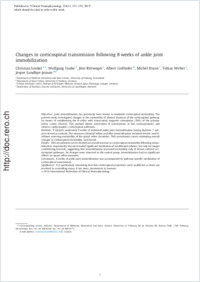Changes in corticospinal transmission following 8 weeks of ankle joint immobilization
- Leukel, Christian Department of Medicine, Movement and Sport Science, University of Fribourg, Switzerland
- Taube, Wolfgang Department of Medicine, Movement and Sport Science, University of Fribourg, Switzerland
- Rittweger, Jörn German Aerospace Centre, Institute of Aerospace Medicine, Division Space Physiology, Cologne, Germany
- Gollhofer, Albert Department of Sport Science, University of Freiburg, Germany
- Ducos, Michel German Aerospace Centre, Institute of Aerospace Medicine, Division Space Physiology, Cologne, Germany
- Weber, Tobias German Aerospace Centre, Institute of Aerospace Medicine, Division Space Physiology, Cologne, Germany
- Lundbye-Jensen, Jesper Department of Nutrition, Exercise and Sports, University of Copenhagen, Denmark - Department of Neuroscience and Pharmacology, University of Copenhagen, Denmark
-
2015
Published in:
- Clinical Neurophysiology. - 2015, vol. 126, no. 1, p. 131–139
Transcranial magnetic stimulation
H reflex conditioning
Motor evoked potential
MEP recruitment
Primary motor cortex
Spinal cord
English
Joint immobilization has previously been shown to modulate corticospinal excitability. The present study investigated changes in the excitability of distinct fractions of the corticospinal pathway by means of conditioning the H-reflex with transcranial magnetic stimulation (TMS) of the primary motor cortex (Hcond). This method allows assessment of transmission in fast (monosynaptic) and slow(er) (polysynaptic) corticospinal pathways.Methods: 9 subjects underwent 8 weeks of unilateral ankle joint immobilization during daytime, 7 subjects served as controls. The measures obtained before and after immobilization included stretch- and H-reflexes assessing excitability of the spinal reflex circuitries, TMS recruitment curves estimating overall changes in corticospinal excitability, and Hcond.Results: TMS recruitment curves showed an overall increase in corticospinal excitability following immobilization. Importantly, Hcond revealed significant facilitation of conditioned reflexes, but only for longer conditioning intervals, suggesting that immobilization increased excitability only of slower, indirect corticospinal pathways. No changes were observed in the control group. Immobilization had no significant effects on spinal reflex measures.Conclusions: 8 weeks of ankle joint immobilization was accompanied by pathway-specific modulation of corticospinal transmission.Significance: It is particularly interesting that fast corticospinal projections were unaffected as these are involved in controlling many, if not most, movements in humans.
- Faculty
- Faculté des sciences et de médecine
- Department
- Département de Médecine
- Language
-
- English
- Classification
- Biological sciences
- License
-
License undefined
- Identifiers
-
- RERO DOC 255907
- DOI 10.1016/j.clinph.2014.04.002
- Persistent URL
- https://folia.unifr.ch/unifr/documents/304225
Statistics
Document views: 115
File downloads:
- pdf: 185
